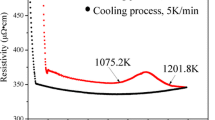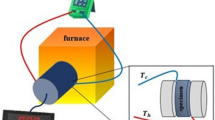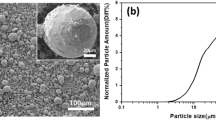Abstract
Undoped n-type Bi2Te3 bulks were prepared via the liquid state manipulation (LSM) with subsequent ball milling and spark plasma sintering processes. The sample with LSM obtains higher carrier concentration and larger effective mass compared with that without LSM, exhibiting favourable electrical transport properties. More importantly, a much reduced lattice thermal conductivity ~ 0.47 W m−1 K−1 (decreased by 43%) is obtained, due to the enhanced multiscale phonon scattering from hierarchical microstructures, including boundaries, nanograins and lattice dislocations. Additionally, due to the increased carrier concentration and enlarged band gap, the bipolar effect is effectively suppressed in sample BT-LSM. Consequently, zTmax ~ 0.66 is achieved in the sample with LSM at higher temperature of 475 K, almost 22% improvement compared with that of the contrast.






Similar content being viewed by others
References
Zhang QH, Huang XY, Bai SQ, Shi X, Uher C, Chen LD (2015) Thermoelectric devices for power generation: recent progress and future challenges. Adv Energy Mater 18:194–213
Zhu TJ, Liu YT, Fu CG, Heremans JP, Snyder JG, Zhao XB (2017) Compromise and synergy in high-efficiency thermoelectric materials. Adv Mater 29:1605884
Hong M, Chasapis TC, Chen ZG et al (2016) n-type Bi2Te3-xSex nanoplates with enhanced thermoelectric efficiency driven by wide-frequency phonon scatterings and synergistic carrier scatterings. ACS Nano 10:4719–4727
Tan G, Zhao LD, Kanatzidis MG (2016) Rationally designing high-performance bulk thermoelectric materials. Chem Rev 19:12123–12149
Yang L, Chen ZG, Dargusch MS, Zou J (2017) High performance thermoelectric materials: progress and their applications. Adv Energy Mater 8:1701797
Chen ZG, Shi X, Zhao LD, Zou J (2018) High-performance SnSe thermoelectric materials: progress and future challenge. Prog Mater Sci 97:283–346
Pan Y, Aydemir U, Sun FH et al (2017) Self-tuning n-type Bi2(Te, Se)3/SiC thermoelectric nanocomposites to realize high performances up to 300 degrees. Adv Sci 4:1–8
Zhang Q, Ai X, Wang L et al (2015) Improved thermoelectric performance of silver nanoparticles-dispersed Bi2Te3 composites deriving from hierarchical two-phased heterostructure. Adv Funct Mater 25:966–976
Li J, Tan Q, Li JF, Liu DW et al (2013) BiSbTe-based nanocomposites with highZT: the effect of SiC nanodispersion on thermoelectric properties. Adv Funct Mater 23:4317–4323
Hu L, Wu H, Zhu T et al (2015) Tuning multiscale microstructures to enhance thermoelectric performance of n-type bismuth-telluride-based solid solutions. Adv Energy Mater 5:1–13
Tan G, Shi F, Hao S et al (2015) Codoping in SnTe: enhancement of thermoelectric performance through synergy of resonance levels and band convergence. J Am Chem Soc 137:5100–5112
Wu D, Zhao LD, Hao S et al (2014) Origin of the high performance in GeTe-based thermoelectric materials upon Bi2Te3 doping. J Am Chem Soc 136:11412–11419
Hong M, Chen ZG, Yang L, Zou J (2016) Enhancing thermoelectric performance of Bi2Te3-based nanostructures through rational structure design. Nanoscale 8:8681–8686
Yang L, Chen ZG, Hong M, Han G, Zou J (2015) Enhanced thermoelectric performance of nanostructured Bi2Te3 through significant phonon scattering. ACS Appl Mater Inter 7:23694–23699
Park K, Ahn K, Cha J et al (2016) Extraordinary off-stoichiometric bismuth telluride for enhanced n-type thermoelectric power factor. J Am Chem Soc 138:14458–14468
Li JF, Liu J (2006) Effect of nano-SiC dispersion on thermoelectric properties of Bi2Te3 polycrystals. Phys Status Solidi A 203:3768–3773
Wang XY, Yu Y, Zhu B et al (2018) The effect of SbI3 doping on the structure and electrical properties of n-type Bi1.8Sb0.2Te2.85Se0.15 alloy prepared by the free growth method. J Electron Mater 42:998–1002
Zhu B, Yu Y, Wang XY, Zu FQ, Huang ZY (2017) Enhanced thermoelectric properties of n-type Bi2Te2.7Se0.3 semiconductor by manipulating its parent liquid state. J Mater Sci 3:8526–8537
Yu Y, Lv L, Wang XY, Zhu B, Huang ZY, Zu FQ (2015) Influence of melt overheating treatment on solidification behavior of BiTe-based alloys at different cooling rates. Mater Des 88:743–750
Yu Y, He DS, Zhang S et al (2017) Simultaneous optimization of electrical and thermal transport properties of Bi0.5Sb1.5Te3 thermoelectric alloy by twin boundary engineering. Nano Energy 37:203–213
Son JH, Oh MW, Kim BS, Park SD (2018) Optimization of thermoelectric properties of n-type Bi2(Te, Se)3 with optimizing ball milling time. Rare Met 37:351–359
Wang XY, Yu J, Zhao RF, Zhu B, Gao N, Xiang B et al (2019) Effects of melting time and temperature on the microstructure and thermoelectric properties of p-type Bi0.3Sb1.7Te3 alloy. J Phys Chem Solids 24:281–288
Zhu B, Huang ZY, Wang XY, Yu Y, Gao N, Zu FQ (2018) Enhanced thermoelectric properties of n-type direction solidified Bi2Te2.7Se0.3 alloys by manipulating its liquid state. Scr Mater 146:192–195
Gao N, Zhu B, Wang XY, Yu Y, Zu FQ (2018) Simultaneous optimization of Seebeck, electrical and thermal conductivity in free-solidified Bi0.4Sb1.6Te3 alloy via liquid-state manipulation. J Mater Sci 53:9107–9116. https://doi.org/10.1007/s10853-018-2209-4
Zhu B, Huang ZY, Wang XY et al (2017) Attaining ultrahigh thermoelectric performance of direction-solidified bulk n-type Bi2Te2.4Se0.6 via its liquid state treatment. Nano Energy 42:8–16
Yu Y, Zhu B, Wu Z, Huang ZY, Wang XY, Zu FQ (2015) Enhancing the thermoelectric performance of free solidified p-type Bi0.5Sb1.5Te3 alloy by manipulating its parent liquid state. Intermetallics 66:40–47
Blachnik R, Igel R (1974) Thermodynamische Eigenschaften von IV–VI-verbindungen: bleichalkogenide/thermodynamic properties of IV–VI-compounds: leadchalcogenides. Z Naturforsch B 29:625–629
Xing T, Liu R, Hao F et al (2017) Suppressed intrinsic excitation and enhanced thermoelectric performance in AgxBi0.5Sb1.5−xTe3. J Mater Chem C 5:12619–12628
Goldsmid HJ, Sharp JW (1999) Estimation of the thermal band gap of a semiconductor from Seebeck measurements. J Electron Mater 28:869–872
Son JH, Oh MW, Kim BS, Park SD, Min BK, Kim MH et al (2013) Effect of ball milling time on the thermoelectric properties of p-type (Bi, Sb)2Te3. J Alloys Comp 566:168–174
Seo S, Lee K, Jeong Y, Oh MW, Yoo B (2015) Method of efficient Ag doping for fermi level tuning of thermoelectric Bi0.5Sb1.5Te3 alloys using a chemical displacement reaction. J Phys Chem C 119:18038–18045
Seo S, Oh MW, Jeong Y, Yoo B (2017) A hybrid method for the synthesis of small Bi0.5Sb1.5Te3 alloy particles. J Alloys Comp 696:1151–1158
Zheng QZ, Su XL, Xie HY et al (2015) Mechanically robust BiSbTe alloys with superior thermoelectric performance: a case study of stable hierarchical nanostructured thermoelectric materials. Adv Energy Mater 5:1401391
Ge ZH, Ji YH, Qiu Y, Chong X, Feng J, He JQ (2018) Enhanced thermoelectric properties of bismuth telluride bulk achieved by telluride-spilling during the spark plasma sintering process. Scr Mater 143:90–93
Fuschillo N, Bierly J, Donahoe F (1959) Transport properties of the pseudo-binary alloy system Bi2Te3−ySey. J Phys Chem Solids 8:430–433
Ioffe AF (1957) Semiconductor thermoelements and thermoelectric cooling, infosearch limited. Infosearch Ltd., London
Wang XY, Wang HJ, Xiang B et al (2018) Thermoelectric performance of Sb2Te3-based alloys is improved by introducing PN junctions. ACS Appl Mater Inter 10:23277–23284
Kim YM, Lydia R, Kim JH, Lin CC, Ahn K, Rhyee JS (2017) Enhancement of thermoelectric properties in liquid-phase sintered Te-excess bismuth antimony tellurides prepared by hot-press sintering. Acta Mater 35:297–303
Hu LP, Zhu TJ, Wang YG, Xie HH, Xu ZJ, Zhao XB (2014) Shifting up the optimum figure of merit of p-type bismuth telluride-based thermoelectric materials for power generation by suppressing intrinsic conduction. NPG Asia Mater 6:1–8
Fei F, Wei Z, Wang Q, Lu P, Wang S, Qin Y et al (2015) Solvothermal synthesis of lateral heterojunction Sb2Te3/Bi2Te3 Nanoplates. Nano Lett 15:5905–5911
Nolas GS, Sharp J, Goldsmid HJ (2011) Thermoelectrics-basic principles and new materials developments. Springer, New York
Blank VD, Buga SG, Kulbachinskii VA et al (2012) Thermoelectric properties of Bi0.5Sb1.5Te3/C60 nanocomposites. Phys Rev B 86:075426
Ahmad S, Singh A, Bohra A, Basu R, Bhattacharya S, Bhatt R et al (2016) Boosting thermoelectric performance of p-type SiGe alloys through in situ metallic YSi 2 nanoinclusions. Nano Energy 27:282–297
Li YY, Yang C, Qu SG, Li XQ, Chen WP (2010) Nucleation and growth mechanism of crystalline phase for fabrication of ultrafine-grained Ti66Nb13Cu8Ni6.8Al6.2 composites by spark plasma sintering and crystallization of amorphous phase. Mater Sci Eng A 528:486–493
Guillon O, Gonzalez-Julian J, Dargatz B et al (2014) Field-assisted sintering technology/spark plasma sintering: mechanisms materials, and technology developments. Adv Eng Mater 16:830–849
Guyon J, Hazotte A, Monchoux JP, Bouzy E (2013) Effect of powder state on spark plasma sintering of TiAl alloys. Intermetallics 34:94–100
Chen Z, Zhang X, Pei Y (2018) Manipulation of phonon transport in thermoelectrics. Adv Mater 30:1705617
Martin J, Wang L, Chen L, Nolas GS (2009) Enhanced Seebeck coefficient through energy-barrier scattering in PbTe nanocomposites. Phy Rev B 79:115311
Kim SI, Ahn K, Yeon DH et al (2011) Enhancement of seebeck coefficient in Bi0.5Sb1.5Te3 with high-density tellurium nanoinclusions. Appl Phys Express 4:091801
Puneet P, Podila R, Karakaya M et al (2013) Preferential scattering by interfacial charged defects for enhanced thermoelectric performance in few-layered n-type Bi2Te3. Sci Rep 3:1–7
Scheele M, Oeschler N, Veremchuk I et al (2012) Thermoelectric properties of lead chalcogenide core–shell nanostructure. ACS NANO 5:8541–8551
Acknowledgements
This work was supported by the National Natural Science Foundation of China (Grant No. 51371073), the Natural Science Foundation of Anhui Province (Grant No. 1808085ME108) and Australian Research Council.
Author information
Authors and Affiliations
Contributions
Dr. Fang Qiu Zu and Dr. Lan Jun Liu conceived and supervised this study. Xiao Yu Wang designed and carried out the thermoelectric experiments. Xiao Yu Wang and Jin Hui carried out the SPS experiment. Xiao Yu Wang, Bo Xiang and Hong Jing Shang analysed the electrical transport data. Xiao Yu Wang, Dr. Bin Zhu and Dr. Zhong Yue Huang analysed the thermal transport data. Dr. Yuan Yu prepared the TEM specimens. Hui Juan Wang carried out the TEM experiment. Xiao Yu Wang and Hui Juan Wang analysed the TEM data. Dr. Bin Zhu and Run Fei Zhao carried out the Hall measurement experiment. Xiao Yu Wang and Dr. Yuan Yu analysed the Hall data. Xiao Yu Wang, Dr. Fang Qiu Zu and Dr. Zhi Gang Chen wrote the manuscript. All authors have reviewed, discussed and approved the results and conclusions of this article.
Corresponding authors
Ethics declarations
Conflicts of interest
The authors declare that they have no conflict of interest.
Electronic supplementary material
Below is the link to the electronic supplementary material.
Rights and permissions
About this article
Cite this article
Wang, Xy., Wang, Hj., Xiang, B. et al. Attaining reduced lattice thermal conductivity and enhanced electrical conductivity in as-sintered pure n-type Bi2Te3 alloy. J Mater Sci 54, 4788–4797 (2019). https://doi.org/10.1007/s10853-018-3172-9
Received:
Accepted:
Published:
Issue Date:
DOI: https://doi.org/10.1007/s10853-018-3172-9




